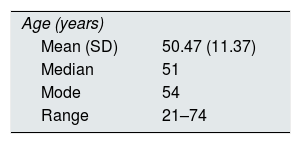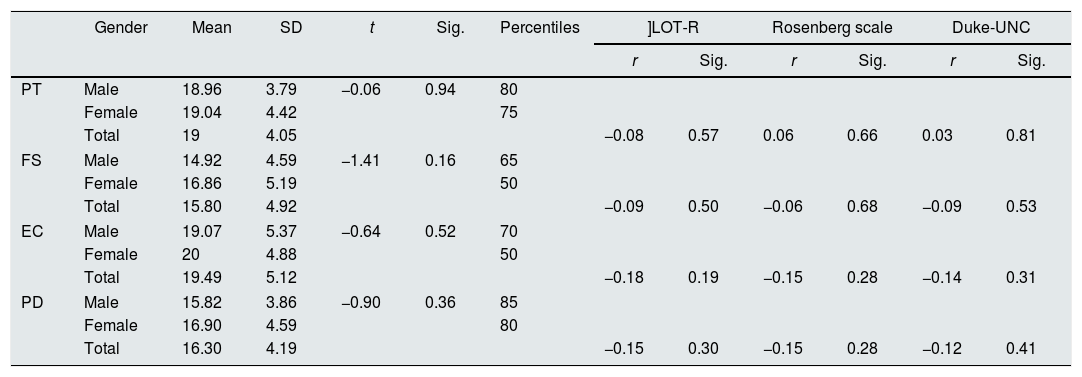Living kidney donation is an eminently prosocial behaviour. Empathy which is the product of cognitive and emotional factors, is a multidimensional motivating factor of prosocial behaviour.1 The objectives of this study were to assess empathic tendency in people who are going to be living kidney donors, and to study the relationship between empathy and other dispositional variables of the donor that might characterise their prosocial behaviour, such as self-esteem, optimism or perceived social support.
We conducted a simple retrospective cross-sectional study from March 2012 to June 2016. A consecutive sample of 58 living kidney donors were assessed in the Nephrology department of Hospital General Universitari Vall d’Hebron. First, the donors were interviewed to explore the basic reasons for donating. Following the interview, they were invited to participate in the study, and its objectives were explained to them. Those who chose to take part signed the consent form. After collecting their sociodemographic data, they were assessed using psychometric tests. The Interpersonal Reactivity Index (IRI),1,2 used to assess empathy, informs about the capacity to understand others and to put oneself in their place based on one's observations and the verbal information received. The test comprises four sub-scales: two cognitive elements, perspective taking (PT) and fantasy (FS), and two emotional elements, empathic concern (EC) and personal distress (PD). The Life Orientation Test-Revised (LOT-R)3 assesses dispositional optimism, referring to the stable belief in having a general expectancy of a positive future. The Rosenberg self-esteem scale4 is an instrument used to assess the personal satisfaction that each person has in him/herself. Duke-UNC5 is a questionnaire that assesses perceived social support.
The statistical tests included a descriptive analysis using measures of central tendency, a Pearson correlation analysis and a comparison of means using non-parametric tests. The analyses were performed using SPSS® version 15 statistical software.
Table 1 shows the sociodemographic characteristics of the study's participants. Given that, in adapting the IRI questionnaire to a Spanish sample, the empathy assessment was differentiated by gender,2 this differentiation was maintained when calculating the percentiles in our sample. Table 2 shows the means and percentiles for each sub-scale of the IRI. There were no significant differences between men and women in the degree of empathy towards organ donation. The percentiles for all IRI sub-scales were higher for men than for women, the most notable difference being with respect to the EC element, which refers to the sentiments of compassion and concern when faced with the discomfort of others. For the PT and PD elements, the values were above the 75th percentile for both men and women.
Sociodemographic characteristics of living kidney donors (N=53).
| Age (years) | |
| Mean (SD) | 50.47 (11.37) |
| Median | 51 |
| Mode | 54 |
| Range | 21–74 |
| No. | Percentage | |
|---|---|---|
| Gender | ||
| Male | 28 | 52.8 |
| Female | 25 | 47.2 |
| Level of education | ||
| Primary | 27 | 50.9 |
| Secondary | 20 | 37.8 |
| University education | 6 | 11.3 |
| Marital status | ||
| Married | 41 | 77.4 |
| Single | 8 | 15.1 |
| Separated/divorced | 3 | 5.7 |
| Widowed | 1 | 1.9 |
| Occupation | ||
| Employed | 37 | 69.8 |
| Retired | 9 | 17 |
| Disabled | 1 | 1.9 |
| Unemployed | 6 | 11.3 |
| Relationship with the recipient | ||
| Spouse | 23 | 43.4 |
| Sibling | 13 | 24.5 |
| Child | 7 | 13.2 |
| Parent | 5 | 9.4 |
| Friend | 5 | 9.4 |
| Mental health history | ||
| Crossover transplantation | 2 | 3.8 |
| Prior renal replacement therapy in the recipient | ||
| None | 29 | 54.7 |
| Haemodialysis | 24 | 45.3 |
Comparison of IRI sub-scales by gender. Percentiles of means differentiated by gender. Correlation of IRI sub-scales with dispositional variables.
| Gender | Mean | SD | t | Sig. | Percentiles | ]LOT-R | Rosenberg scale | Duke-UNC | ||||
|---|---|---|---|---|---|---|---|---|---|---|---|---|
| r | Sig. | r | Sig. | r | Sig. | |||||||
| PT | Male | 18.96 | 3.79 | −0.06 | 0.94 | 80 | ||||||
| Female | 19.04 | 4.42 | 75 | |||||||||
| Total | 19 | 4.05 | −0.08 | 0.57 | 0.06 | 0.66 | 0.03 | 0.81 | ||||
| FS | Male | 14.92 | 4.59 | −1.41 | 0.16 | 65 | ||||||
| Female | 16.86 | 5.19 | 50 | |||||||||
| Total | 15.80 | 4.92 | −0.09 | 0.50 | −0.06 | 0.68 | −0.09 | 0.53 | ||||
| EC | Male | 19.07 | 5.37 | −0.64 | 0.52 | 70 | ||||||
| Female | 20 | 4.88 | 50 | |||||||||
| Total | 19.49 | 5.12 | −0.18 | 0.19 | −0.15 | 0.28 | −0.14 | 0.31 | ||||
| PD | Male | 15.82 | 3.86 | −0.90 | 0.36 | 85 | ||||||
| Female | 16.90 | 4.59 | 80 | |||||||||
| Total | 16.30 | 4.19 | −0.15 | 0.30 | −0.15 | 0.28 | −0.12 | 0.41 | ||||
EC: empathic concern; FS: fantasy; IRI: Interpersonal Reactivity Index; LOT-R: Life Orientation Test-Revised; PD: personal discomfort; PT: perspective taking; SD: standard deviation.
Source: Mestre et al.2
Correlations between age and IRI sub-scales were only significant in the negative sense for the FS element (rFS: –0.37, α=0.00; rPT: –23, α=0.09; rEC: –0.08, α=0.55; rPD: –0.13, α=0.36). A relationship between donor and recipient (spouse, sibling, child, friend, parent) also did not affect the various elements of empathic tendency (PT: χ2=1.77, α=0.77; FS: χ2=7.74, α=0.10; EC: χ2=1.65, α=0.79; PD: χ2=3.89, α=0.42). Conversely, comparing whether or not the recipient had started renal replacement therapy prior to transplant, this significantly affected the empathic tendency of the donor for the PD element (PT: t=0.07, α=0.94; FS: t=0.31, α=0.75; EC: t=0.80, α=0.42; PD: t=2.18, α=0.03).
The donors’ mean scores on dispositional variables such as optimism (LOT-R: 23.39; SD: 3.13), self-esteem (Robrg: 33.78; SD: 4.17) and perceived social support (Duke-UNC: 45.18; SD: 6.77) are high. However, the correlations between the IRI scale and these variables are not significant (Table 2).
Our results are in agreement with other studies on living kidney donors, which have not found differences between men and women in their disposition towards donation.6 Moreover, in relation to the empathic disposition towards organ donation, men scored more highly than the general male population, around the 85th percentile. Mapping the type of relationships to empathic tendency did not reveal any significant correlation. Conversely, empathic tendency was affected by the perception of the recipient's suffering,1,2 associated in our study with having started renal replacement therapy prior to transplant.
As in other studies,7 the majority of living donations in our study (96.34%) were to people who maintain emotional ties with the donor, and the donors are fully aware of who their donation is going to.8 Therefore, in the majority of cases living donation is not unconditional, but direct and partial. This has led to debate in the scientific literature regarding the consistency of the concept of altruism when discussing living donation.9,10
Living donors have high scores in dispositional variables such as optimism, self-esteem and perceived social support, but the correlation of empathic tendency with these variables is not significant. We can therefore conclude that empathy refers to a concept with standalone value in organ donation.
The study has limitations that might affect the extrapolation of the results, as it was conducted in a single centre with a small sample size.
We would particularly like to thank the participants who completed the questionnaires and shared their concerns and experiences regarding the organ donation process with us.
Please cite this article as: Costa-Requena G, Moreso FJ, Torres IB, Parramon G, Seron D. Evaluación de la empatía en donante vivo de riñón. Nefrologia. 2018;38:570–572.








